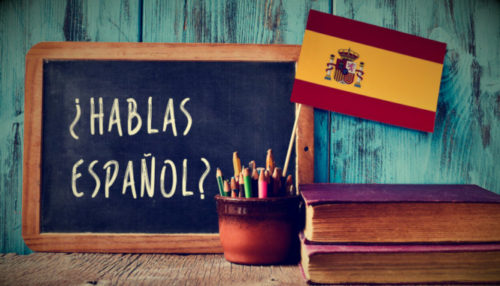I’ve tried to learn Spanish several times, but I’m sorry to say I haven’t had much luck. The first time was in high school, and my high school offered the choice faced by many in United States rural and/or lower income communities: a couple of French classes or a couple of Spanish classes. I chose Spanish. The courses were painfully slow, and I didn’t pick up much.
Later on in college, like many former Catholics who majored in philosophy, I took Latin courses for my language requirement. Latin obviously isn’t Spanish, but it’s helpful. And then, about 6 months ago, I took up Spanish again via podcasts called Coffee Break Spanish.
More Americans should learn Spanish. Why? Minimally, Americans should learn some language other than English. Many Americans make it through life as total monolinguists. This is much less common in lots of other places. And, sadly, I count myself among the Americans who don’t really know a second language. Sure, I can muddle my way through lots of Latin texts and some German texts. I’ve picked up a basic understanding of Spanish, though I still can’t speak it.
I think all that’s a shame. It’s a manifestation of US-chauvinism and our excessively English-centric international business, cultural, and scientific climates.
4 Reasons to Learn Spanish
So…why learn Spanish? Let’s talk about that. Here are some reasons I think about.
1. Spanish is the second most common language in the US.
This post is obviously pretty US-centric. On that note, if you live in the US and you don’t know Spanish, it means you don’t know the second most common language in your own country. How many Americans speak Spanish? We have pretty extensive data on that. Recent surveys show about 13.4% of Americans, or about 41 million people. About 10 million of that 41 million speak Spanish more or less exclusively.
These numbers are growing. To learn Spanish, therefore, is to learn the language of an important, and increasingly important, part of the country.
2. Spanish is the fifth most common language in the world.
And we’re not talking about just the US. Spanish is the fifth most commonly spoken language in the world, with more than 500 million speakers. As with the others in the top 5, there’s a story here. Much of the story is one of Spanish colonialism and empire. But the background facts remain. Spanish is a language of international business and culture.
Narrowed down only to first languages, Spanish becomes the second most common world language.
3. Spanish is a great language for world travel.
Spanish is great for travelers, and there are lots of places in the Spanish-speaking world I’d love to see. Argentina, Chile, and Mexico stand out at the top of my list. As does Spain, especially Barcelona and the surrounding Catalan region. It’d help to learn Spanish.
Can you go to these places without command of the Spanish language? Sure. I’m sure there are lots of English-language tours and tourist areas where plenty of people speak English. I’ve traveled to Berlin twice with only very minimal German abilities, and I had little trouble getting around. The same is probably true of Spanish-speaking places. But it’s all very limiting.
What’s the best way to expand your travel options in Spanish-speaking regions? Learn Spanish.
4. Spanish is a critical language of outreach for many activist groups and organizations.
Lately, I’ve focused on tenants union activism. We’ve done a ton of door-to-door canvassing and other forms of outreach (e.g., flyers, brochures). We cover lots of neighborhoods, with an exclusive focus on renters and strong working on working class neighborhoods. Who will you find in these neighborhoods? All sorts of people, but a higher proportion of Latinx people and non-English speakers than you’ll find in other parts of Iowa City.
Most of the people who answer the door speak English, regardless of what their first language may have been. But sometimes that’s not the case. Occasionally someone speaks only Arabic, but Spanish is the most common non-English language. To be clear, even this isn’t necessarily a major communication barrier. In the few times I’ve knocked on the door and the person spoke only Spanish, someone else in the household has been able to provide adequate translation. Usually the person’s child. I’ve never had an incident while canvassing where I was totally unable to communicate with the person.
But there’s a deeper point here. To learn Spanish is to broaden one’s ability to communicate effectively. And I think it also sends a message of solidarity.
Bonus Reason: Preservation of Language and Culture
My grandfather grew up in an immigrant town just outside of Houston. Immigrants from many countries lived there, but two countries loomed large: the Czech Republic and Mexico. My grandfather’s parents were born in the former. The idea of a Czech-Mexican town might sound strange to people now. These two groups don’t have much in common in 2019. But if you work back through history, there’s a story here of two very different paths toward ‘becoming American’ (or, in many cases, ‘becoming white’).
Czech-Americans are white Americans. I’m white and so is my dad. But US culture normalized Czechs as white Americans somewhat gradually. My grandfather was born in 1932 near the conclusion of this period of acceptance. As Czechs became fully white, they left behind the Czech language. And my grandfather follows that pattern. He grew up bilingual to parents who spoke mostly Czech. Gradually he lost the Czech language, and neither my father nor I speak a word of Czech.
For Latinx people, the road to acceptance has been longer and bumpier. While I don’t think English-speaking Americans trying to learn Spanish is some kind of panacea, I do think it can be helpful in sending the message that acceptance doesn’t have to mean giving up the Spanish language.
Even better if we lived in a world where acceptance doesn’t come tied to becoming white.
